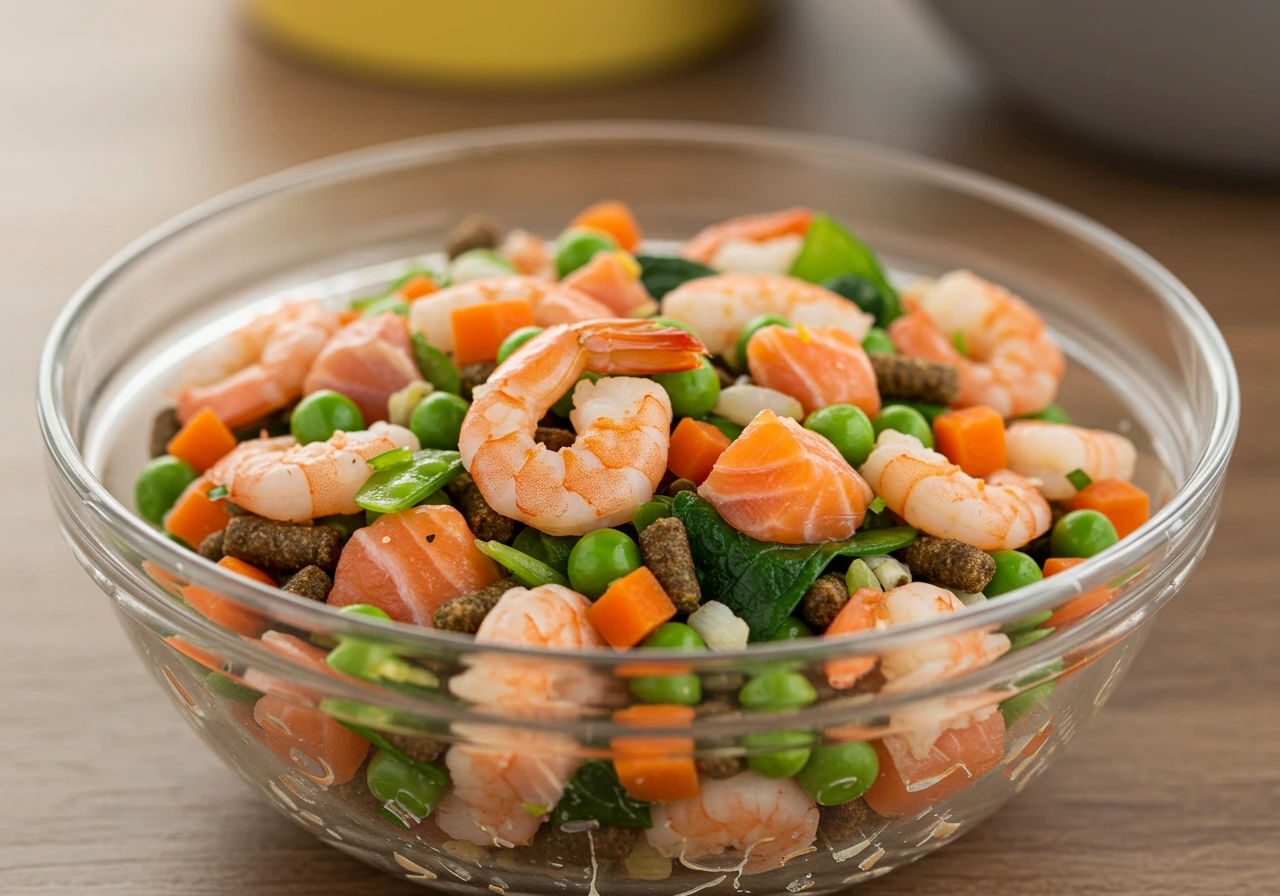Introduction
Crafting a fish food recipe from scratch isn’t just a fun kitchen project—it’s a heartfelt way to provide your aquatic pets with nutritious, tailor-made meals that support their well-being. Whether you’re raising fancy goldfish, vibrant guppies, or a whole community of tropical swimmers, learning to whip up homemade fish food allows you to control every crumb and ensure your underwater buddies are getting the best. This article dives deep into the why, what, and how of DIY fish food, backed by practical experience, nutrition science, and a touch of creative flair.
Let’s begin with the very first part of our guide: understanding the dietary needs of your fish—because just like us, not every fish is a one-meal-fits-all kind of creature.
Part 1: Nutritional Needs of Aquarium Fish
Understanding Fish Nutrition Basics
Fish may live in water, but their nutritional needs are anything but watered down. At the heart of any effective fish food recipe is a balanced blend of proteins, fats, carbohydrates, and essential micronutrients. Different species have unique dietary blueprints, but a few principles stay the same across the tank.
Let’s break it down:
- Protein: This is the lifeblood of fish diets. Most aquarium species, especially carnivores and omnivores, require protein levels ranging from 30% to 50%. It helps with growth, tissue repair, and maintaining energy. Think krill, bloodworms, or even finely chopped fish fillet.
- Fat: While too much fat can spell trouble, healthy fish fats are crucial. They support cellular function and serve as a clean-burning energy source. Typically, fat should make up 3% to 10% of the diet, often sourced from shrimp shells, fish oil, or flaxseed.
- Carbohydrates: Unlike cats or dogs, fish don’t heavily rely on carbs. Still, they need a bit for fiber and energy. That’s where blended veggies like peas, spinach, or zucchini shine.
- Vitamins & Minerals: From vitamin C that boosts immunity to calcium that keeps bones strong, these tiny nutrients play a colossal role. Without them, fish can face growth stunts, diseases, and short lifespans.
🐟 Pro Tip: If your fish seem sluggish or their colors are fading, chances are they’re lacking something vital—usually protein or vitamins. Adjust the mix and observe.
Tailoring Nutrients by Fish Type
No two fish are exactly alike, and their meals shouldn’t be either.
Carnivorous Fish
Species like bettas, arowanas, and angelfish are protein monsters. They thrive on diets high in meat-based ingredients like:
- Chopped prawns or tilapia
- Insect larvae (like blackworms or bloodworms)
- Mussels or clams (blended, of course)
These fish have shorter digestive tracts, meaning they’re built to process protein efficiently. Veggies? Not so much.
Herbivorous Fish
Now, here’s a curveball: fish like plecos, mollies, or mbuna cichlids need plant-based goodness. Their longer intestines are designed for slow, steady digestion of:
- Blanched spinach and kale
- Algae wafers or spirulina
- Slices of cucumber or zucchini
If you feed them too much protein, it can lead to bloating and organ strain.
Omnivorous Fish
Ah, the best of both worlds. Goldfish, guppies, and tetras love a combo plate. Their diet can include both animal-based and plant-based ingredients. That makes them ideal candidates for homemade fish food recipes that blend shrimp, veggies, and multivitamin supplements.
Signs of Nutritional Imbalance in Fish
Not sure if your current fish food is doing its job? Watch out for:
- Dull coloration: Often due to a lack of vitamins A or C.
- Lethargy: Could stem from insufficient protein or fatty acids.
- Bloating or constipation: Usually a sign of overfeeding or incorrect fiber content.
- Fin rot or scale loss: Suggests an immunity dip, likely from missing nutrients.
So, instead of playing the guessing game with commercial flakes, making your own blend puts you in control.
Why Knowing Fish Nutrition Matters
When I first tried my hand at a DIY fish food recipe, I had no idea how sensitive my guppies were to changes in protein levels. After a week of testing, I noticed brighter colors and faster swimming—all from a simple swap from store flakes to a blended mix of shrimp, peas, and spirulina.
It’s not magic. It’s just meeting your fish where their stomachs are.
Besides, once you understand what your fish truly need, you’re no longer bound to what manufacturers decide. You can customize textures, nutrient ratios, and even feeding formats.
And, oh—did I mention how much cheaper it is in the long run?
Part 2: Understanding Fish Dietary Requirements
Nutritional Needs of Aquarium Fish
When it comes to fish care, nothing is more underrated yet utterly crucial than nutrition. Just like people, fish need a specific balance of nutrients to grow, stay active, and dazzle us with their colors. So before you even pull out the blender for that DIY fish food recipe, you’ve gotta know what to include—and more importantly, why.
Proteins: Essential Building Blocks
Proteins are the holy grail of fish nutrition. They’re the foundation of tissue repair, fin growth, reproduction, and general vitality. Whether your fish is zipping through the tank or lounging at the bottom, chances are, it’s protein that powers that behavior.
- Animal-based protein sources like shrimp, fish fillet, or insect larvae are ideal for carnivorous and omnivorous fish.
- Herbivores still need protein, but they usually get it from plant sources such as spirulina, seaweed, and soy-based binders.
An adult fish might only need around 30–40% protein, but juveniles or breeding fish can shoot up to 50%. So don’t skimp on this—it’s the difference between thriving and just surviving.
Fats: Energy Sources
Yep, even fish need healthy fats. Fats are more than just fuel—they help in the absorption of fat-soluble vitamins (A, D, E, and K), support nerve function, and add flavor to meals (yes, fish have taste preferences too).
But moderation is key. Too much fat can cloud the water, clog your filter, and even cause fatty liver disease in some species. Stick with omega-rich options like flaxseed oil or fish oil for a clean, slow-burning energy source.
Carbohydrates: Limited but Necessary
Carbs in a fish food recipe? Absolutely—just not too much.
Fish aren’t big carb lovers by design, especially carnivores. But a small dose of easily digestible carbs like sweet potato, peas, or pumpkin provides necessary fiber and energy. Herbivores appreciate this more than meat-eaters, but even omnivores benefit from a touch of carbs.
The secret? Balance the carbs with moisture and fiber, or you’ll end up with constipated fish (trust me, it’s a thing—and it ain’t pretty).
Vitamins and Minerals: Supporting Overall Health
Fish can’t always make or store the vitamins they need, which means their food has to do the heavy lifting.
- Vitamin C strengthens immunity and helps with wound healing.
- Vitamin A supports vision and growth.
- Calcium and phosphorus are vital for bone development.
- Iron, zinc, and iodine regulate hormones and metabolism.
And don’t forget the micronutrients—even trace elements play a pivotal role in health. A sprinkle of a high-quality multivitamin or liquid supplement can round out your blend beautifully.
Variations in Diet Based on Fish Species
Not all fish speak the same food language. Depending on their biology, lifestyle, and even tank mates, their diets can—and should—differ wildly.
Carnivorous vs. Herbivorous vs. Omnivorous Fish
- Carnivores, like bettas and angelfish, have short digestive tracts designed for high-protein, meaty diets. They crave krill, shrimp, or even small feeder fish.
- Herbivores, like plecos and mollies, need lots of fiber. They graze all day on algae, vegetables, and plant matter.
- Omnivores—think goldfish, guppies, or most cichlids—can adapt to a variety of ingredients, enjoying both animal protein and vegetable matter.
The key is to match your fish food recipe to the species. Otherwise, you might overfeed one and undernourish another.
Specific Dietary Considerations for Popular Aquarium Fish
- Goldfish: Thrive on a balanced mix of carbs, greens, and low-fat protein. Avoid high-fat blends—they’re prone to swim bladder issues.
- Discus: Prefer soft, protein-rich meals like beef heart paste (used sparingly) and bloodworms.
- Tetras and Barbs: Love high-protein flakes with veggie bits. A dash of garlic juice enhances immune response.
- Cichlids: These bold swimmers benefit from color-enhancing foods like spirulina and astaxanthin-infused shrimp.
Part 3: Advantages of Homemade Fish Food
Control Over Ingredients and Quality
If you’ve ever squinted at the back of a commercial fish food container trying to decode mystery ingredients, you’re not alone. Making your own fish food recipe puts the power back where it belongs—in your hands.
Ensuring Freshness and Nutritional Value
Let’s be real—store-bought fish food can sit on a shelf for months, even years. That means the nutrients degrade over time, especially sensitive vitamins like C and E. When you craft your own blend, you choose ingredients at peak freshness. Think just-blanched spinach, newly minced shrimp, and vitamin-rich vegetables that still retain their vibrant color and nutritional punch.
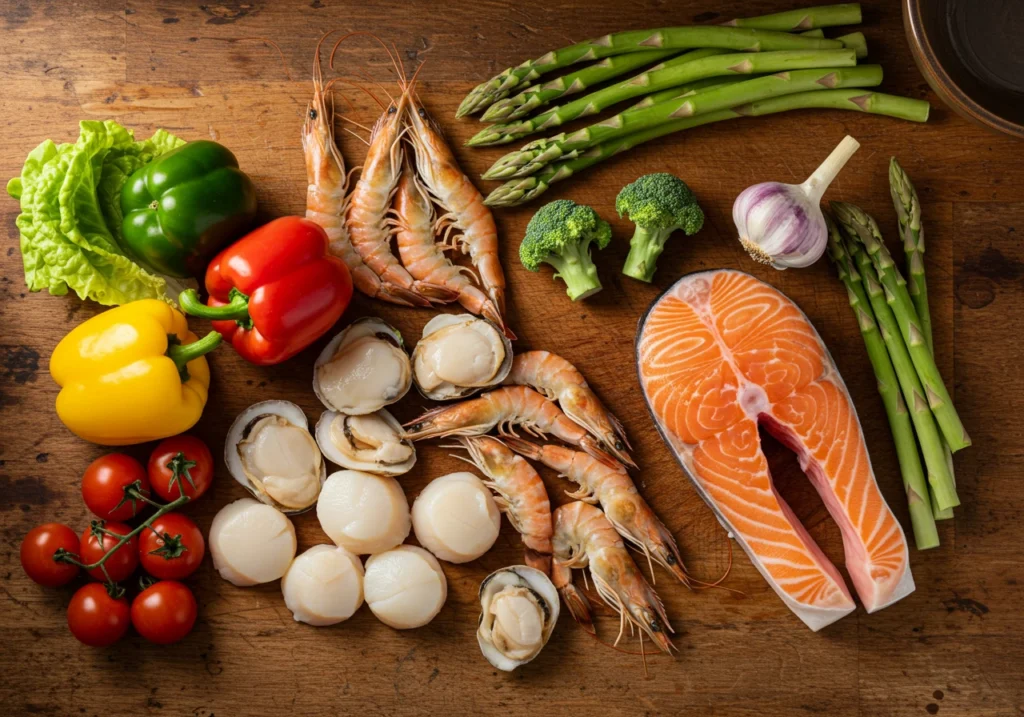
The result? Healthier fish with more energy, brighter colors, and better growth rates.
Avoiding Harmful Additives and Preservatives
Most commercial foods are preserved with synthetic chemicals, fillers, and artificial colors—many of which aren’t great for your fish (or your filter). Homemade food skips the junk. No artificial dyes. No unknown binders. Just whole ingredients your fish were practically built to digest.
That peace of mind? Priceless.
✅ Recommended: ReefBum’s DIY Fish Food Guide goes in-depth on choosing raw, safe, preservative-free ingredients.
Cost-Effectiveness and Customization
Sure, a can of commercial food might seem cheap upfront, but when you calculate long-term health costs, wasted flakes, and spoiled food? That price tag starts to look… fishy.
Tailoring Recipes to Specific Fish Needs
Here’s the magic sauce—customization. You’re not feeding a generic population of “aquarium fish.” You’re feeding your fish. That includes their species, age, activity level, and even health conditions.
Have a picky betta? Blend in a touch of garlic to boost appetite. Need to help your goldfish with digestion? Add fibrous peas and skip high-fat meats. You can tweak textures (gel, flakes, or paste), portion sizes, and even flavor enhancers—something no off-the-shelf product offers.
Economical Benefits Over Commercial Options
Let’s crunch some numbers: buying individual ingredients like shrimp, peas, and spinach in bulk can make dozens of batches—each lasting weeks in the freezer. Compared to tiny jars that run out in days, the savings add up fast.
Part 4: Essential Ingredients for DIY Fish Food
One of the biggest advantages of preparing your own fish food recipe is the freedom to choose exactly what goes into it. With the right ingredients, you’re not just feeding your fish—you’re nourishing them. Let’s dive into the must-have components that form the backbone of any well-rounded, nutritious fish meal.
Protein Sources
Protein is the anchor of most fish diets. It fuels growth, energizes movement, and supports immune function. In a homemade fish food recipe, protein should always be front and center—especially for carnivores and omnivores.
Fresh Seafood: Shrimp, Fish Fillets, Mussels
Fresh is best—no doubt about it. Shrimp (peeled and deveined), white fish fillets like tilapia or cod, and mussels are all excellent protein choices. They’re soft, easy to blend, and rich in amino acids that your fish crave.
Not only do they pack a punch nutritionally, but they also enhance the taste and texture of your food mix, making it irresistible—even for picky eaters. Just chop them finely or puree them depending on your tank mates’ size.
Frozen Options: Mysis, Daphnia, Krill
Frozen foods are a great backup and can boost variety. Mysis shrimp, daphnia, and krill are loaded with nutrients and mimic the natural diet of many fish species.
What makes these a winner? They’re convenient, safe from parasites (if processed correctly), and retain most of their nutrients. Just be sure to thaw and rinse them before use to avoid excess phosphates in your tank.
🌊 Pro Tip: Rotate between fresh and frozen to ensure your fish get a diverse nutritional spectrum.
Vegetable Matter
Even meat-loving fish need plant-based foods in their diet—fiber aids digestion and helps balance gut health. Herbivores, on the other hand, absolutely thrive on greens.
Leafy Greens: Spinach, Kale
These powerhouse veggies are packed with iron, calcium, and essential vitamins. Kale and spinach should be blanched quickly (30 seconds in boiling water) to soften their fibers and make them easier for fish to digest.
They blend seamlessly into homemade pastes or gel foods, adding roughage and vital nutrients to your mix.
Other Vegetables: Carrots, Peas, Bell Peppers
- Peas (skinned and boiled) are fantastic for preventing constipation in goldfish and bettas.
- Carrots add beta-carotene, which enhances color—especially reds and oranges.
- Bell peppers, surprisingly, are loaded with vitamin C and antioxidants.
The trick? Steam or boil them lightly, then chop or puree them before mixing with proteins and binders. This adds not only nutrition but also natural sweetness that fish find quite appealing.
✅ Need more ideas? The Planted Tank forum has great discussions about safe veggies for aquarium diets.
Supplements and Additives
Your base is set, but let’s not forget the small extras that make a huge difference. Supplements round out your recipe and ensure your fish get everything they need to thrive.
Vitamins: Fish-Specific Multivitamins
Adding a few drops of a liquid fish vitamin supplement can elevate your mix. Look for products with stabilized vitamin C, B-complex, and D3 to support stress resistance, bone health, and vibrant coloration.
These can be added directly into your blended mix before freezing or during feeding (if your food is gel or soft-form).
Binders: Gelatin or Agar-Agar for Gel Food
Want to form a solid cube or slab of fish food that holds together underwater? Use gelatin or agar-agar.
- Gelatin is easier to source but less stable in higher temps.
- Agar-agar, a vegan seaweed-based binder, is perfect for warm tanks and plant-based diets.
You’ll only need a tablespoon or two, heated and whisked into your mix before cooling.
Enhancements: Garlic for Immune Support
Here’s a game-changer—garlic. It’s a natural antiparasitic, immune booster, and appetite enhancer. A few drops of garlic juice or crushed clove in your blend can help your fish eat better and fend off common illnesses.
It’s especially helpful when transitioning fish to homemade food or coaxing stressed or sick fish to eat.
Part 5: Preparing Homemade Fish Food
So, you’ve gathered all your powerhouse ingredients. Now it’s time to turn those nutritious bits into an irresistible fish food recipe your aquatic buddies will gobble up. Making your own fish food doesn’t require a lab or fancy equipment—just a few common kitchen tools and a bit of love for your finned friends.
Equipment and Tools Needed
Before you dive into mixing, blending, and freezing, make sure you’ve got the following essentials lined up. Trust me, having the right tools makes the whole process smoother and a lot less messy.
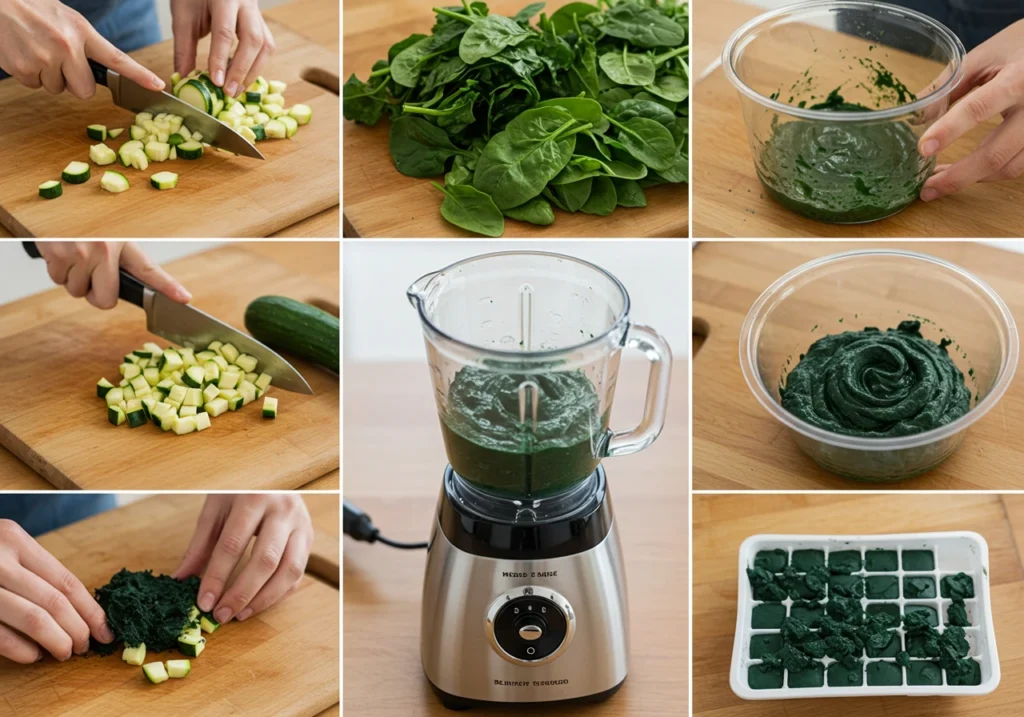
Blender or Food Processor
This is your MVP. Whether you’re working with chunky mussels or fibrous kale, a good-quality blender or food processor will break everything down into a soft paste. Go for something with pulse settings to control texture—especially useful for creating custom blends.
Mixing Bowls and Utensils
You’ll need a few bowls to separate wet from dry ingredients and a rubber spatula or spoon for stirring. Stainless steel bowls are ideal since they don’t retain odors or react with acidic foods.
Ice Cube Trays or Freezer Bags for Storage
Once your mix is ready, it needs to be stored in manageable portions. Silicone ice cube trays are a lifesaver—they make it easy to pop out frozen servings. Alternatively, use labeled freezer bags and flatten them for quick defrosting.
🎯 Pro Tip: Dedicate these tools solely to fish food prep if you can. No one wants garlic shrimp smoothie leftovers in their next human meal.
Basic Preparation Steps
Let’s get cooking—figuratively. While there’s no baking or boiling involved (unless prepping veggies), this is where the magic happens.
Selecting and Preparing Ingredients
Start by choosing your proteins and veggies. Opt for fresh, clean ingredients with no additives. Here’s a quick prep guide:
- Shrimp or mussels: Peel, rinse, and chop.
- Leafy greens: Blanch in boiling water for 30 seconds to soften.
- Peas and carrots: Boil until tender; remove skins from peas.
- Supplements: Add just before blending, so they don’t degrade.
Everything should be chopped small enough to blend but large enough to retain texture (unless you’re feeding tiny fry).
Blending to Desired Consistency
Place all ingredients into your blender. Add a little tank water or unflavored gelatin mix to help blend it smoothly. Pulse in short bursts, checking consistency every few seconds. The goal?
- For omnivores and carnivores: A smooth paste or thick slurry.
- For herbivores: A coarser blend with visible veggie bits.
If you’re using gelatin or agar-agar, now’s the time to mix it in. Dissolve it separately in warm water, then combine with your food paste while warm.
Portioning and Freezing for Long-Term Use
Once your blend is ready, spoon it into silicone ice cube trays or drop dollops onto a parchment-lined baking tray. Freeze for a few hours until solid.
After freezing:
- Pop cubes into airtight freezer bags.
- Label with the date and recipe ingredients.
- Store for up to 3 months.
💡 Reminder: Only thaw what you need. Refreezing can break down nutrients and texture.
This method saves time, reduces waste, and gives your fish consistent, well-balanced meals with every bite. Plus, there’s something oddly satisfying about seeing rows of nutrient-packed cubes ready to feed your underwater crew.
Part 6: Personal Experience with Homemade Fish Food
Creating my own fish food recipe wasn’t something I did on a whim. Honestly, I was tired of second-guessing the flaky labels on commercial food and watching my fish either ignore their meals or suffer from digestive issues. So, I rolled up my sleeves, hit the kitchen, and gave it a shot. And wow—what a difference it made.
Testing the Recipes
Observations on Fish Acceptance and Preference
From the first feeding session, the reaction was telling. My goldfish darted toward the food with uncharacteristic excitement, nipping at the softened gel chunks like they’d been waiting their whole lives for it. Even my more cautious betta, usually a picky eater, hovered by the dropper waiting for his turn. I tried a few blends: one heavy on shrimp, one more plant-based with peas and spinach, and a third balanced version with both.
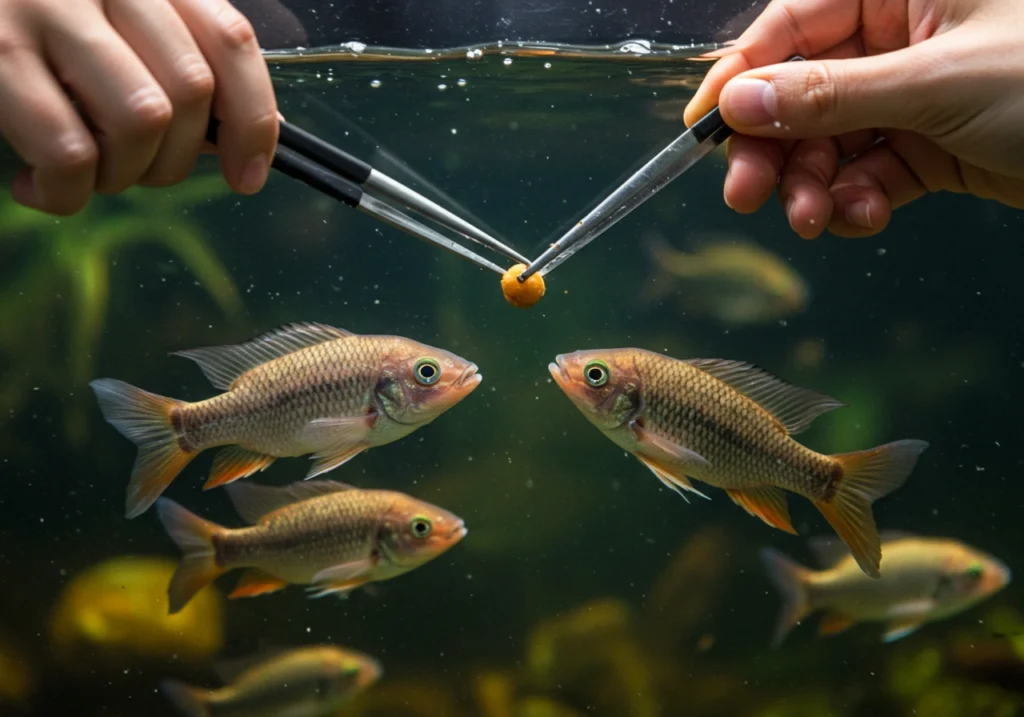
Each fish had its own favorite. The omnivores went for the mixed blend, while the herbivores devoured the green paste like salad-lovers at a buffet. My angelfish surprisingly preferred krill-heavy batches over mysis shrimp—go figure.
Adjustments Made Based on Fish Response
After a week of testing, I noticed that one recipe was clouding the water slightly—turns out, too much gelatin was the culprit. So, I dialed it down and added more fibrous veggies, which also helped one of my guppies bounce back from a mild case of constipation (yep, that happens in fish too!).
I also started adding garlic extract and a drop of liquid multivitamin, and within days, everyone seemed hungrier, livelier, and visibly brighter.
Notable Benefits and Improvements
Enhanced Fish Health and Vibrancy
Within two weeks, the physical changes were unmistakable. My goldfish, who’d always had a muted orange hue, started showing off a deeper, richer color. The betta’s fins looked more pronounced and velvety. No joke—my aquarium looked like someone hit the HD button.
I also noticed less waste collecting on the tank floor. Because the food was fresher and better balanced, there was less leftover mess, which meant cleaner water and happier filters. Win-win.
Behavioral Changes and Increased Activity Levels
Beyond looks, their behavior shifted too. My cichlids became more interactive during feeding time, gathering like eager puppies. The previously shy tetra school started coming out more often, especially after feeding.
But what really sold me? The spawning. That’s right—two of my mollies bred just weeks after switching to homemade food. It was like a little underwater celebration of health and vitality.
Switching to a homemade fish food recipe didn’t just feel rewarding—it actually was rewarding. My fish are not only surviving—they’re thriving. And the peace of mind that comes from knowing what they’re eating? That’s the cherry on top.
Part 7: Storage and Shelf Life
Once you’ve whipped up that perfect fish food recipe, the last thing you want is to let it go to waste. Proper storage isn’t just about keeping food from spoiling—it’s about preserving nutrients, maintaining hygiene, and making feeding time a total breeze.
Proper Storage Techniques
Freezing vs. Refrigeration
Hands down, freezing is the go-to method for long-term storage of homemade fish food. It locks in freshness, prevents bacterial growth, and ensures your carefully crafted nutrients don’t break down too quickly.
- Freeze in small portions—ice cube trays or silicone molds are perfect.
- Once frozen, pop them into labeled, airtight freezer bags.
- Shelf life in the freezer: 2 to 3 months.
Refrigeration works only for short-term use—maybe 3 to 5 days max—and it must be stored in an airtight container to prevent contamination. Any longer than that, and you’re risking nutrient loss or worse—spoilage.
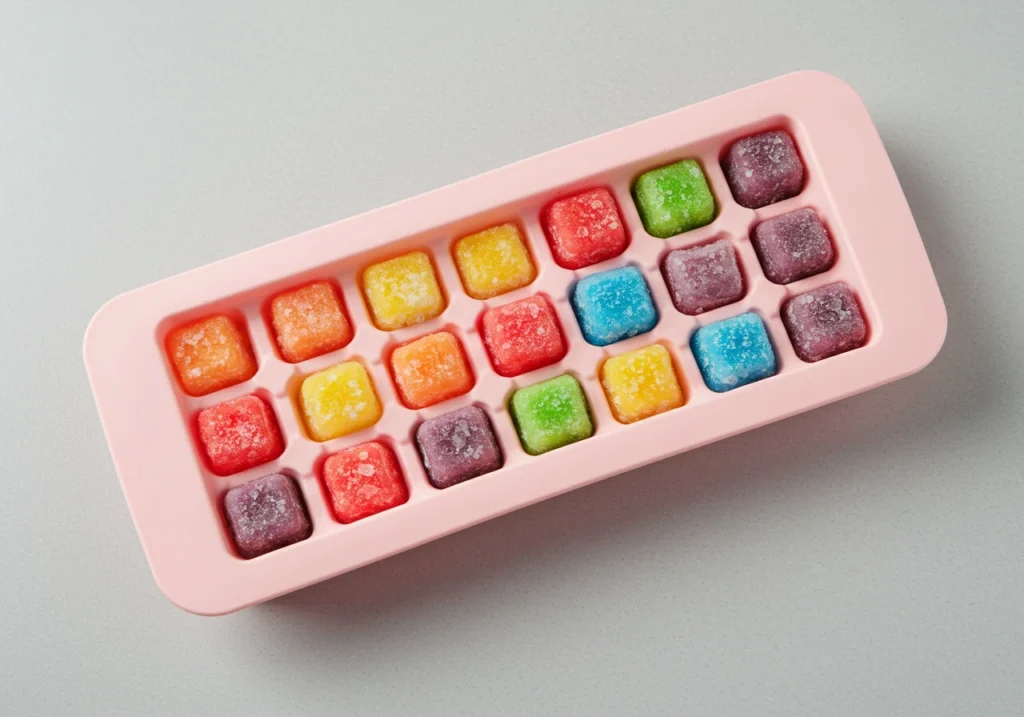
Portion Control to Minimize Waste
Let’s be real—feeding too much at once not only pollutes your tank but also wastes your effort. Pre-portion your mix based on your tank size and number of fish. This way, you can thaw only what’s needed without waste or mess.
Tip: Flatten freezer bags after filling; it makes snapping off a piece much easier than chiseling out a cube.
Understanding Shelf Life and Spoilage Signs
Indicators of Spoiled Fish Food
Even frozen food has a life span. Watch out for these red flags:
- Color changes: If your vibrant green or pinkish mix starts turning gray or brown, it’s likely oxidized.
- Foul odor: A sharp or sour smell is your cue to toss it.
- Slimy texture after thawing: This could mean bacterial growth—don’t risk it.
Your fish might even tell you first—if they’re refusing food they once devoured, something’s probably off.
Tips for Maintaining Freshness
- Always use clean utensils when scooping portions—cross-contamination is real.
- Label your batches with dates and ingredients to track freshness.
- Don’t refreeze thawed food—it degrades the nutritional content and texture.
🐟 Quick Note: Fish have keen senses. Even slight spoilage can make them turn their noses—err, gills—up.
Maintaining freshness is part of responsible fishkeeping. It ensures your finned friends get all the benefits of your homemade efforts without compromise.
Part 8: Frequently Asked Questions (FAQs)
What is the best homemade food for fish?
The best homemade fish food depends on your fish species. For most aquarium fish, a balanced blend of shrimp, peas, spinach, and spirulina works wonders. Carnivores prefer protein-rich options like fish fillet or krill, while herbivores thrive on leafy greens like kale and blanched zucchini. Adding a multivitamin supplement can ensure they get all the necessary nutrients. Ultimately, the best food is one that mimics your fish’s natural diet, is made from fresh ingredients, and meets their species-specific needs.
How to make homemade fish feed?
Start with fresh or frozen ingredients. Choose a protein base like shrimp or fish, add vegetables such as peas or spinach, and blend everything until smooth. Incorporate binders like gelatin or agar-agar if you want a gel consistency. Add a few drops of fish-safe multivitamin and garlic juice for immune support. Once mixed, portion the blend into ice cube trays or silicone molds, then freeze. Thaw only what you need and serve in small amounts. Easy, customizable, and your fish will love it.
How to make fish food for aquarium fish?
Begin by selecting safe, nutritious ingredients your specific fish will benefit from. For omnivorous aquarium fish, combine chopped seafood (like tilapia or shrimp) with veggies (like kale and bell peppers). Lightly blanch vegetables to aid digestion. Add any powdered or liquid supplements, then blend everything to your preferred texture. Use gelatin or agar to bind, and pour the mix into trays to freeze. Feed thawed portions in small amounts once or twice a day, adjusting based on appetite and tank conditions.
What are the ingredients of fish food?
Common ingredients in homemade fish food recipes include:
- Proteins: shrimp, fish fillets, mussels, daphnia
- Vegetables: peas, carrots, spinach, kale
- Supplements: multivitamins, garlic, spirulina
- Binders: gelatin, agar-agar These ingredients vary depending on whether your fish are carnivores, herbivores, or omnivores. For balanced nutrition, always include a mix of macronutrients (proteins, fats, carbs) and micronutrients (vitamins and minerals). Avoid preservatives, dyes, and anything you wouldn’t eat yourself.
How do I prevent homemade fish food from clouding the water?
Cloudy water usually results from overfeeding, poor mixing, or too many binders. To prevent this:
- Use small, well-blended portions.
- Avoid overloading gelatin—it can dissolve too quickly.
- Rinse any frozen ingredients (like mysis or krill) before blending.
- Feed only what your fish can consume within 2–3 minutes. Also, consider freezing your mix into firm gel cubes rather than using loose paste, which can disintegrate faster. Maintaining good filtration and consistent feeding habits will also keep your tank sparkling clean.
Are there specific recipes for fry (baby fish)?
Yes! Fry need high-protein, soft-textured food to support rapid growth. A popular blend includes:
- Boiled egg yolk (mashed into water)
- Infusoria (microscopic aquatic organisms)
- Finely ground shrimp or fish
- Spirulina powder Mix into a smooth paste or add to a gel-based formula and feed in tiny amounts several times daily. Avoid overfeeding—uneaten food can quickly foul the water. As fry grow, transition them gradually to finely crushed versions of adult food.

